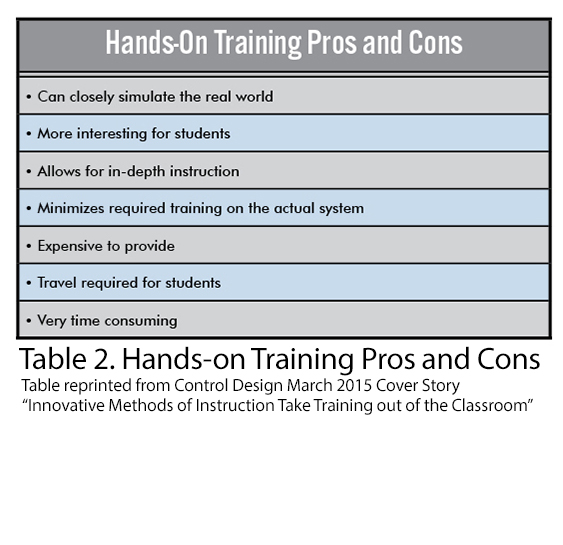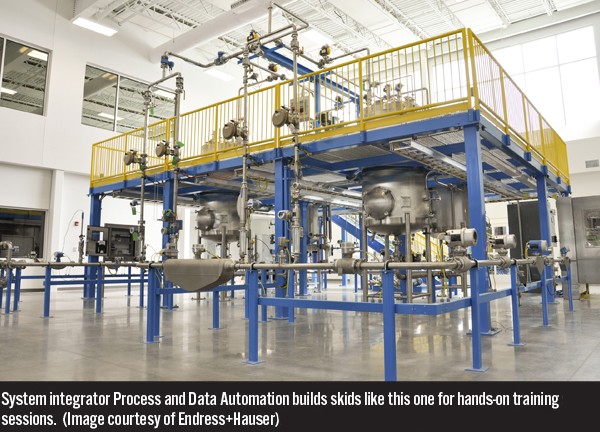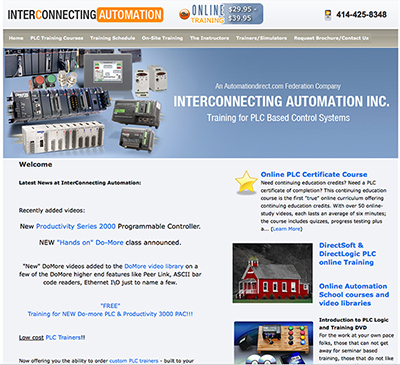Teachers often cover subject matter at the speed of the least experienced student, which is helpful for them, but is less productive for more advanced trainees. Classroom training in general can be quite tedious, and also very expensive compared to more modern alternatives. For these and other reasons, machine builders, process skid OEMs and suppliers are transitioning to hands-on and online training.
The advantages of online training compared to the classroom are many. The student controlling the pace of the training is one advantage, as the experienced or advanced students no longer have to wait or fight to stay awake while the teacher explains the basics to the beginners.
In some instances, hands-on instruction has advantages over online training, but it has its own set of issues. The simulation of real world machines, process and equipment is a great learning tool.
This article discusses how both online and hands-on instruction are changing training for machine automation professionals.
Training Online
As noted in the Control Design cover story and according to the e-Learning Industry web site, online training is growing rapidly:
- In 2011, it was estimated that about $35.6 billion was spent on e-Learning worldwide. Today, e-Learning has become a $56.2 billion industry, and continues to grow at a rapid pace.
- Corporations say e-Learning is their second most valuable training method.
- About 46% of college students are currently taking at least one course online. By 2019, roughly half of all college classes will be e-Learning-based.
Interest in online training is increasing among automation professionals. Located in Mukilteo, Washington, Electroimpact designs and builds turn-key automation assembly systems for commercial aircraft wings and riveting machines.
In the Control Design, March 2015 cover story, “Electroimpact Trains Its EEs,” Laurence Durack, lead electrical engineer at Electroimpact, says, “I’ve taken advantage of some amazing free online lectures from MIT and find them to be of great benefit. In some ways they are better than sitting in class as you can stop and repeat any points you miss. I can see a transformation of the whole education process with tools such as this, and I feel the existing approach is ripe for overhaul.” For more from Durack, see the section titled: “How to Train an EE”.[hozbreak]
In the cover story, Scott Hendrickson, CEO of Olympus Controls, a systems integrator serving machine builders from their base in Seattle, also sees the value of online instruction. “We’ve looked at online training programs through a company called BlueVolt that delivers a web-based learning management system. Their cloud-based platform delivers professional training programs on just about any machine automation technology.”
In the same Control Design cover story, Randy Ransom, director of training at Intelligrated, a material handling OEM in Mason, Ohio, has an interesting approach to e-Learning. “Requiring students to complete online e-Learning training modules prior to an instructor-led session provides a baseline of knowledge for all students,” he explains. “This allows the instructor to begin training at a deeper level since the basic concepts and terminology have already been covered. Students also tend to ask more probing questions during the instructor-led training sessions when they’ve been exposed to the initial e-Learning training.”
Virtual hands-on equipment is also available for some courses. Delta Computer Systems offers two-day online training classes where the students interact with actual Delta RMC motion controllers via the Internet.
“The hands-on, instructor-led training covers setup, tuning, programming and diagnostics of RMC motion controllers for closed-loop position and velocity control through a series of lessons and lab exercises,” explains Bill Savela in the cover story. “Closed-loop motion control is a new concept to many hydraulic engineers, and Delta has found that by giving students hands-on experience they can complete their machine development much more quickly and with fewer support requirements,” says Savela, marketing director at Delta.
A wide variety of online training is available, with course durations ranging from less than a minute to over one hour. There is also a wide range of pricing from free to several thousand dollars.
An engineer at a mining industry equipment manufacturer noted in the cover story that pricing is a problem. “Online training available on demand is something companies are willing to pay for,” he notes in the cover story. “Maybe it’s not being offered more widely because organizations doing the training have not been able to determine a realistic value. With courses where there is a signup, if the number of participants does not equal a good return, the class can be cancelled. Once material is out on the web and priced, it may be more difficult to adjust the price after the fact.”
Get Your Hands on It
Adding hands-on training to classroom training is a good option since it can help students experience and operate automated systems firsthand. Joseph W. Snyder, president of Process and Data Automation, a systems integrator in Erie, Pennsylvania, builds its own process training units (PTUs) to provide this hands-on experience. 
“While there are options to purchase off-the-shelf configured trainers, we typically use internally-constructed systems,” says Snyder in the cover story. “Building these systems ourselves also allows us to use the entire specification and build process of new process skids as an internal training course in project management.” For more on how they use skids for training, see the section titled: “Process Training Units”.
Hands-on training works best if the staff turnover is low, says Nick Stephens, managing director for 22solutions, a systems integrator in Ballarat, Australia. “We believe hands-on training is most effective if the staff attrition rate is low,” he explains in the cover story. “With a low attrition rate we generally find the users have been working with similar products so they understand processes and the system. People like this type of one-on-one training as it feels more personal to them to see someone in the flesh who designed/created the system they are about to take responsibility for.”
Best in Class
Classroom training has a long history and works best in some instances. “We rely on many of our supplier partners to train our new hires on their specific technology,” says Hendrickson in the cover story.
“Parker Hannifin provides a comprehensive six-week program, which gives our new hires an excellent understanding of the technologies that are the foundation for the automation industry.”
“Parker Hannifin was one of the first companies in the motion control industry to establish an intensive immersion program for new college graduates,” he continues in the cover story. “The highlight of the training program is the final project week, where students are broken up into teams and assigned projects that tie the six weeks of training into a final test of imagination and creativity requiring mechanical, electrical, and software skills.”
It’s very common for industry organizations to provide online, hands-on and classroom training or all in combination. In the cover story, Carl Henning, deputy director of PI North America, says they offer 30-60 minute webinars, free Profinet one-day training classes, PROFItelevision with video how-to’s and one-minute You Tube discussions. “MinutePROFINET is the most popular with 5,000 views per month,” continues Henning in the cover story. “One-day training classes are held in at least 16 North American cities per year, and attendance has risen every year.”
Training Improvements
Training in the basics of automation will also be needed, and trade associations are well placed to provide it. In the cover story, Hendrickson says, “Two of the main trade associations for the automation industry – the Motion Control Association and the Association for High Technology Distribution – are developing training programs to introduce new hires to technology fundamentals.”
In the same cover story, Ben Furnish, division marketing manager at Parker Hannifin, adds, “The Packaging Machinery Manufacturers Institute and their Alliance for Innovation and Operational Excellence are teaming up to develop a curriculum for training workers in the automation field.”
Industry will benefit as these organizations create training curricula, as will everyone as training methods expand to fit the desires and needs of students, whether recent graduates or long-time industry veterans.
Process Training Units (PTU)
As discussed in a sidebar to the cover story, system integrator Process and Data Automation does an impressive amount of training. President Joseph W. Snyder says, “We have 29 total people, with 20 in the controls engineering department. In addition to supplier-run training and continuing education through organizations like ISA and the Project Management Institute, our company has created miniature processing systems here at our site.”
The Control Design cover story notes that Process and Data Automation has several simple processing labs used by their technicians and controls engineering department for hands-on training on new field equipment, controllers and control methods. Subjects learned include:
- Instrumentation setup
- Instrumentation integration to controller
- VFD configuration
- Networked I/O commissioning
- Control loop programming
- Complex system programming
“We use home-constructed systems (PTUs) to accomplish this,” explains Snyder. “Many of the systems have multiple PLC platforms per skid so we can cross-train staff on more than one control platform, and help them learn how signals are processed differently by various equipment suppliers.”
Several of the PTUs were built as part of a cooperative effort between internal personnel and students at Penn State University, the experience serving as part of the students’ senior design projects.
Process and Data Automation has built several of these trainers, all of which emulate real-world systems. “The idea is not to mimic everything we encounter in the field, but rather to expand training to include real field devices and applications,” notes Snyder.
Process and Data Automation also uses supplier classroom instruction and hands-on training to improve technical and engineering knowledge of various subjects such as programming, network configuration and instruments. “Our systems allow us to take what’s learned in theory-heavy classes and put that into actual operation,” says Snyder. “Our engineers don’t need to make the leap from a theory course to directly working on live equipment at a client’s site. This allows them to make the proper mental connections and really understand
how the theoretical world interacts with physical connections.”
How to Train an EE
Electroimpact builds complete automation assembly systems for commercial aircraft wings. They also build riveting machines and tools for wing panel and fuselage assembly, advanced fiber placement machines, robotic assembly systems and spacecraft transportation equipment.
Their new engineering hires need further training in the basics, notes Laurence Durack in the cover story. “The subjects covered by educational institutions are changing, especially for EE degrees,” laments Durack, lead electrical engineer. “With the ever increasing areas of specialization, institutions are dropping the fundamentals from the curriculum. I’ve interviewed many EEs with very good qualifications on paper, but who are in reality are very weak in areas such as basic physics, AC circuit analysis, transformers, etc.”
Despite the noted EE weaknesses, most do well with software and can easily work with specialized programs from suppliers. “The problem is they rely on the software to solve everything, when in reality what they are trying to achieve is impossible as they miss some fundamental issues,” says Durack in the cover story. “I’ve had candidates who can’t draw a sine wave, have never studied transformers, and have told me it’s all DC now and there’s no AC.”
Electroimpact is motivated to provide its own training. “We use a combination of supplier training and on-the-job training,” says Durack in the cover story. “For an initial introduction of a new technology we may use supplier training, but as our knowledge increases we rely mostly on in-house on-the-job training. The in-house training is by far the best as the training is focused directly on the application.”
Electroimpact also invites the supplier to provide training onsite. “This is beneficial for two reasons,” he explains in the cover story. “The training is focused on our area of application, and groups from different departments can get together for cross pollination of new ideas. As long as the supplier focuses on the technical side, I’m happy. Recently we had a class on Profinet and I had a very positive response. We are just starting the switch from Profibus to Profinet and it was really informative. Furthermore, I put all the information they gave me on our network for online learning. It’s not only great for people who missed the class, but also as a general reference for any of our locations around the world.”
InterConnecting Automation
In 1996, AutomationDirect teamed up with Doug Bell and InterConnecting Automation to provide training for PLCs and other AutomationDirect products. Through InterConnecting Automation, Doug and his staff provide online and onsite training and seminars across the United States.
InterConnecting Automation online PLC training courses include:
- Introductory Course for PLC-Based Controls
- Advanced PLC Training Course
- PID Computer-Based Training
- Intro Video DVD PLC Training Course
- Analog I/O Video DVD Training Course
- Online PLC Training
- CLICK PLC Trainer
All InterConnecting Automation’s technical instruction is delivered in a clear and concise method. The company’s videos and tutorials are specific and address points at various levels of training. The tutorials cover time-saving suggestions and advanced programming techniques, as well as showing programming examples that are common on simple automation controls. The company’s mission is for students who complete the courses to feel comfortable with basic through advanced PLC programming.
 Many participants use the online video training to learn the basics of the products and then move on to the more advanced courses. All the completed courses offer Continuing Education Credit to those who finish and pass the course. The most advanced classes attract those students who want to learn more and attend the training in a classroom with hands-on access to the products, including how to program a machine from scratch. This type of real world use is what people are looking for in this type of high-level training so they can use the knowledge in their everyday work. Bell explains: “We offer most of this type of training on-site at large companies. It’s full of information but you also get play time. What could be more fun than a group of engineer types sitting in a room programming?”
Many participants use the online video training to learn the basics of the products and then move on to the more advanced courses. All the completed courses offer Continuing Education Credit to those who finish and pass the course. The most advanced classes attract those students who want to learn more and attend the training in a classroom with hands-on access to the products, including how to program a machine from scratch. This type of real world use is what people are looking for in this type of high-level training so they can use the knowledge in their everyday work. Bell explains: “We offer most of this type of training on-site at large companies. It’s full of information but you also get play time. What could be more fun than a group of engineer types sitting in a room programming?”
To find out more about Doug Bell and InterConnecting Automation, visit his website.
Originally Posted: Jan. 28, 2016


